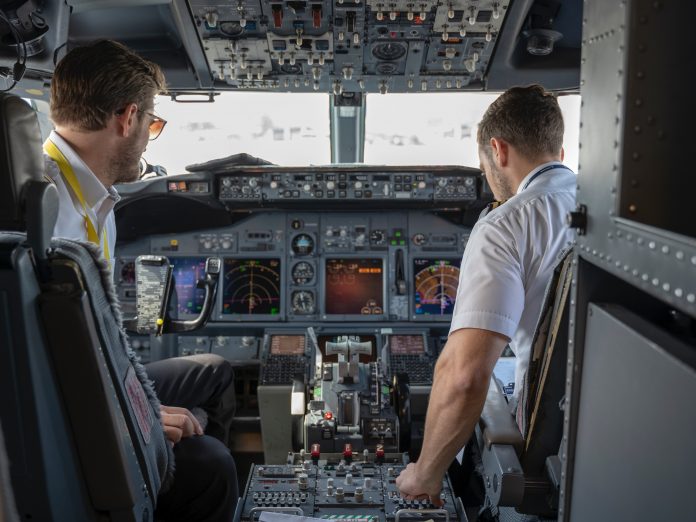Communication is a factor when it comes to proper aircraft operation. Without it, no plane is ever going to take off, let alone reach its final destination. Gone are the days of using wing wave or rapid tail deflection to communicate with ground personnel. Aircraft communication systems have evolved quite dramatically. One can say that they have evolved along with the aircraft themselves. Traditionally, aircraft communication systems use either VHF (very high frequency) or HF (high-frequency) analog voice. However, in the 1980s, data-based communication methods started to become more and more common in aircraft. Aircraft communication is slowly moving towards the use of computers and automation. Due to this reason, scientists and engineer developments to make communication between the ATC and aircraft personal more effective and efficient.
Aircraft used to transport civilians, such as commercial airplanes, are equipped with radios with the sole purpose of analog voice communication. It is the most up to date way of communication between pilots and ATC. However, due to technological advancements, new communication techniques have been introduced over the years. If you feel motivated in knowing how the aircraft communication works, then this article will be helpful for you. Thus, this article will share with you some different forms of aircraft communication methods. Some of these communication methods are listed below;
-
RADIO SPECTRUM ALLOCATIONS
Radio spectrums are defined mainly by the ITU(International Telecommunications Union), and it relates to the use of specific frequency bands for different services. When it comes to civil aviation, the ITU has allocated different radio spectrums for communication, surveillance, and navigation. It is due to the safety regulations of the ATC. The frequencies that the ITU has allocated range from the HF (high frequency, 3-30 MHZ) to the VHF (very high frequency, 118-137 MHZ) range. Whenever any aircraft personnel comes in contact with the dynamic air traffic control simulation, he or she studies in detail the available frequency ranges.
However, the audio quality over the HF range is not good when compared to VHF, due to the long-wave propagation. But VHF also has a disadvantage as pilots cannot use it to communicate over a long distance because the VHF waves cannot penetrate through obstacles such as mountains and buildings. VHF radio communication has been in use since the past six decades, and technological advancements continue to lower the frequency ranges to allow pilots to use a wide range of RF spectrums.
-
ACARS (AIRCRAFT COMMUNICATIONS ADDRESSING AND REPORTING SYSTEM)
ACARS became available in 1978 due to heavy reliance on computers for aircraft communication and navigation. Aircraft equipped with ACARS can exchange messages through a network of computers present on the ground. ACARS powered aircraft communicate with computer systems installed on-ground, usually through the VHF range, interfaced via satellite. Through this satellite uplink, pilots can send out messages to the ground units that get connected through a terrestrial network to a centralized data service processor. Messages can be sent out through satellite uplink only. However, it will connect to the service processor that supports ACARS through VHF in any case.
The main disadvantage of ACARS is the use of character codes that only represent printable characters. It was a limitation that plagued all previous computerized communication systems in general, but this limitation did not stop the ACARS system from becoming a standard in airline communication.
-
VIA SATELLITE
The use of satellite has been ever-present for communication between aircraft and ground personnel for the last twenty-five years. Although satellite communication was used mainly as a method of communication by ships, it slowly found its way into commercial airliners, business jets, and government aircraft. Four satellites were launched in the geostationary orbit, which are centralized over the Indian ocean, Pacific ocean, Atlantic ocean-west, and Atlantic ocean-east, and it offers a coverage of 80 degrees below and above the equator.
It provides two modes of communication; circuit mode and packet mode. Circuit mode carries out voice communication between passengers and the flight deck crew; however, packet mode sends out packets of digital data to ACARS supported Radios. The use of packet mode has encouraged radio manufacturers to add ACARS support to their HF radios. Due to this reason, HDFL (high-frequency data links) have been installed on the ground to add more support for ACARS. These new and improved HF radios can easily switch between packet mode and circuit mode using the same piece of communication equipment. However, preference is given to circuit mode, as there is no better form of communication than to listen to a person’s voice.
Also, the addition of ACARS capability to radios is a great way for pilots to make use of HF radios that already exist in their cockpits. One disadvantage of the HFDL system is that it takes around 2 to 3 minutes to transmit messages as compared to 20 to 30 seconds over a satellite.
FINAL WORDS
Aircraft communication systems have come a long way since the Wright brothers took the first flight, and Charles Taylor used hand gestures to signal them and accidentally became the first-ever air traffic controller. Communication devices are evolving with every passing day with aviation technology. Due to this reason, the demand for efficient and effective ways of aircraft communication has increased drastically. To sum up, it is all down to the pilots, and how good of an understanding they have regarding the communication devices present inside the cockpit. Today, we have shared with you some modes of communication that an aircraft uses. So, it is a good idea to study them, to increase your knowledge about aircraft communication.

